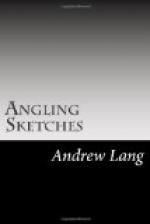It was worth while to be a boy then in the south of Scotland, and to fish the waters haunted by old legends, musical with old songs, and renowned in the sporting essays of Christopher North and Stoddart. Even then, thirty long years ago, the old stagers used to tell us that “the waiter was owr sair fished,” and they grumbled about the system of draining the land, which makes a river a roaring torrent in floods, and a bed of grey stones with a few clear pools and shallows, during the rest of the year. In times before the hills were drained, before the manufacturing towns were so populous, before pollution, netting, dynamiting, poisoning, sniggling, and the enormous increase of fair and unfair fishing, the border must have been the angler’s paradise. Still, it was not bad when we were boys. We had Ettrick within a mile of us, and a finer natural trout-stream there is not in Scotland, though now the water only holds a sadly persecuted remnant. There was one long pool behind Lindean, flowing beneath a high wooded bank, where the trout literally seemed never to cease rising at the flies that dropped from the pendant boughs. Unluckily the water flowed out of the pool in a thin broad stream, directly it right angles to the pool itself. Thus the angler had, so to speak, the whole of lower Ettrick at his back when he waded: it was a long way up stream to the bank, and, as we never used landing-nets then, we naturally lost a great many trout in trying to unhook them in mid water. They only averaged as a rule from three to two to the pound, but they were strong and lively. In this pool there was a large tawny, table-shaped stone, over which the current broke. Out of the eddy behind this stone, one of my brothers one day caught three trout weighing over seven pounds, a feat which nowadays sounds quite incredible. As soon as the desirable eddy was empty, another trout, a trifle smaller than the former, seems to have occupied it. The next mile and a half, from Lindean to the junction with Tweed, was remarkable for excellent sport. In the last pool of Ettrick, the water flowed by a steep bank, and, if you cast almost on to the further side, you were perfectly safe to get fish, even when the river was very low. The flies used, three on a cast, were small and dusky, hare’s ear and woodcock wing, black palmers, or, as Stoddart sings,
Wee dour looking huiks are the thing,
Mouse body and laverock wing.
Next to Ettrick came Tweed: the former river joins the latter at the bend of a long stretch of water, half stream, half pool, in which angling was always good. In late September there were sea-trout, which, for some reason, rose to the fly much more freely than sea-trout do now in the upper Tweed. I particularly remember hooking one just under the railway bridge. He was a two-pounder, and practised the usual sea-trout tactics of springing into the air like a rocket. There was a knot on my line, of course, and I was obliged to hold him hard.




